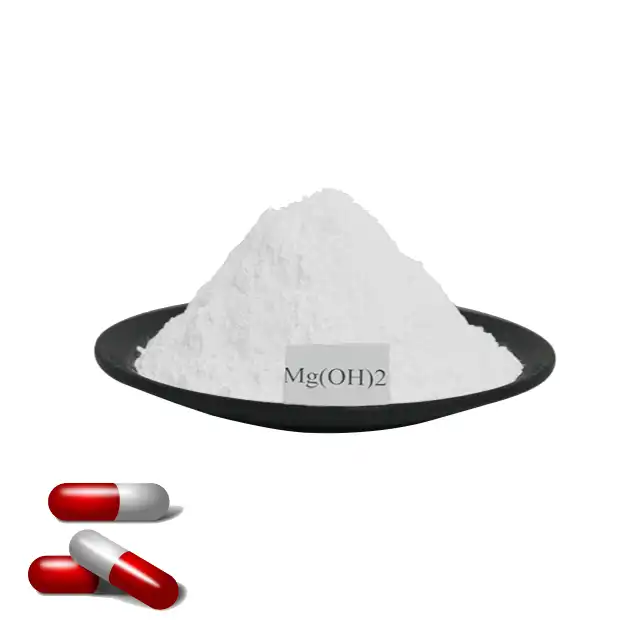Hexavalent chromium Cr(VI) is a Class I human carcinogen, which causes serious environmental pollution due to its wide application and large-scale production. Through the digestive tract, respiratory tract and skin, Cr(Ⅵ) can invade the human body and cause kidney failure, liver failure and toxicity in reproductive and respiratory systems. Cellular level research has found that Cr(VI) can generate oxidative stress in the process of cellular metabolism reduction through the “ingestion-reduction” model, causing damage to proteins and nucleic acids, inducing cell apoptosis and cycle blockage, and even leading to cancerous changes.

Nano magnesium hydroxide (Mg(OH)2) is an environmentally friendly adsorbent that has been applied to treat heavy metal ions in water bodies, such as the treatment of hexavalent chromium. After adsorption of Cr(VI), the nano Mg(OH)2 can be recycled through treatment, while the chromium salt can be concentrated and enriched for reuse in industrial production.
However, nanomaterials will inevitably produce co-exposure to the environment with heavy metal ions. As nanomaterials have the characteristics of easy to migrate in the environment, not easy to settle, and very small particle size, which leads to the environmental transit of the adsorbed pollutants. After adsorption of heavy metal pollutants, nanomaterials can have the properties of both, and the biological effects and environmental behaviors can be altered, creating unknown threats for the entire ecosystem.
Current studies on the biological effects associated with the co-exposure of nanomaterials and heavy metals are mainly focused on exploring the synergistic and accumulation-promoting effects of nanomaterials on the toxicity of heavy metal ions in aquatic organisms, whereas studies on the mechanisms at the cellular level are almost nil.
Based on this, the hypothesis that nanomaterials of Mg hydroxide are difficult to be taken up by cells through endocytosis was proposed. Adsorption of hexavalent chromium using magnesium hydroxide nanoparticles can reduce the cellular uptake of hexavalent chromium, thus reducing chromium-induced cytotoxicity. The adsorption of dichromate using magnesium hydroxide nanoparticles generated Mg(OH)2/Cr(VI) nanocomplexes. The nanomaterials were present in the cell culture solution in a dispersed state of adsorbed protein. Subsequently, the adsorption of heavy metal pollutant Cr(VI) by Mg(OH)2/ Cr(VI) nanocomplexes was used as a model, and HepG2 and HEK293 were selected as the research subjects to study whether Mg(OH)2/ Cr(VI) nanocomplexes would have an effect on the biological effect of heavy metal ion Cr(VI) on cells.
The study was carried out in three main aspects:
First, the effect of nano-magnesium hydroxide on the ability of Cr(Ⅵ) ions to enter cells after adsorption of Cr(Ⅵ) was quantitatively investigated. Anion channel inhibitors were introduced to shield the cellular uptake of free Cr(Ⅵ) ions on the nanomaterials to more accurately summarize how the adsorbed chromium complexes on magnesium hydroxide nanoparticles enter the cells.
Second, the apparent toxicity of Cr(Ⅵ) adsorbed on magnesium hydroxide nanomaterials versus the equivalent amount of free Cr(Ⅵ) ions on the cells of two higher organisms was comparatively tested. Ion channel inhibitors were introduced to summarize the toxicity of the chromium adsorption complex itself on cells by magnesium hydroxide nanoparticles.
Thirdly, based on the toxic mechanism of Cr(VI) ions, the causes of cytotoxicity caused by Mg(OH)2/Cr(VI) nano-complexes were deeply investigated from three aspects, namely, oxidative stress, cell-cycle blockage, and apoptosis. It was found that Mg(OH)2/Cr(VI) was difficult to enter the cell by endocytosis, and Cr(VI) adsorbed on Mg(OH)2/Cr(VI) nanocomplexes was difficult to enter the cell by diffusion again. As a result, the cellular uptake of adsorbed Cr(VI), the corresponding cytotoxic effects and oxidative stress appeared to be significantly reduced.The Nano-Mg(OH)2/Cr(VI) complex itself did not cause significant cytotoxicity and oxidative stress.
The safety evaluation of the environmental remediation behavior of nanomaterials in terms of cellular level demonstrated that Nano-Mg(OH)2/Mg(VI) can be used as a safe and effective adsorbent in the field of environmental pollutant management. Theoretically interpreting the nanomaterials can realize the reduction of toxicity by changing the cellular uptake of heavy metal pollutants. Nano-magnesium hydroxide adsorbent can be an ideal model of environmental adsorbent.

